
We now have two meta-analyses to suggest that light loads can produce similar hypertrophy to heavier loads, provided repetitions are performed to or close to failure (the point at which no more repetitions can be performed) (one, two).
As a note, meta-analyses are studies that combine the results of numerous studies that look at the same topic.
In the two meta-analyses, the vast majority of studies had subjects use loads between 85% and 30% of their one-rep max, roughly equating to repetitions between 5 and 35.
But, what about less than 5 reps? Could this still be effective for building muscle?
Table of Contents
In a previous article, we evaluated the research exploring if maxing out (1 rep training) was effective at building muscle.
In this article, we will evaluate the research exploring the effectiveness of repetitions between 2 and 4 for building muscle mass.
Less Than 5 Reps: The Research
Schoenfeld et al.
Starting things off, Schoenfeld et al. split 19 men with at least 1 year of training experience into a heavy group or moderate group.
Both groups trained the bench press, overhead press, lat pull-down, cable row, back squat, leg press, and leg extension for 3 sets to failure and 2 minutes of rest between sets, 3 times per week for 8 weeks.
The heavy group used a load that allowed them to perform 2-4 reps to failure each set.
The moderate group used a load that allowed them to perform 8-12 reps to failure each set.
Attempts to progressive overload were made for both groups throughout the study.
Increases in vastus lateralis thickness were significantly greater for the moderate group. Increases in elbow flexor thickness also favor the moderate group, while triceps thickness increases were similar between both groups.
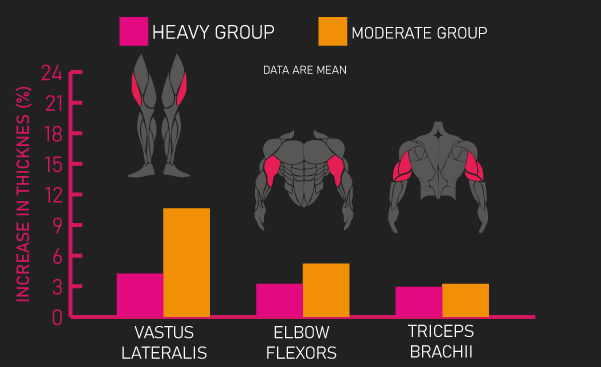
So overall, this study indicates 2-4 reps is not as effective as 8-12 reps.
Weiss et al.
Weiss et al. split 44 untrained men into a low rep, moderate rep, or high rep group.
All groups trained 4 sets on the barbell squat (to 100 degrees of knee flexion) with 6 minutes of rest between sets, 3 times per week for 7 weeks.
The low rep group used a 3-5 rep-max load for each set. The moderate rep group used a 13-15 rep-max load for each set. The high rep group used a 23-25 rep-max load for each set.
Attempts to progressive overload were made for both groups throughout the study.
Increases in quadriceps thickness were similar between all three groups, suggesting reps below 5 are effective for maximizing muscle growth.
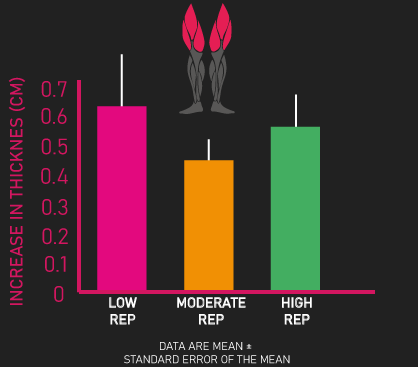
Mangine et al.
Mangine et al. divided 33 men with at least 2 years of training experience into an intensity group or volume group.
Both groups trained 4 times per week for 8 weeks. The program is listed below.

The intensity group performed each exercise for 4 sets of 3-5 reps with a 90% one-rep max load and 3 minutes of rest between sets.
The volume group performed each exercise for 4 sets with 10-12 reps with a 70% one-rep max load and 1 minute of rest between sets.
Attempts to progressive overload were made for both groups throughout the study.
Increases in rectus femoris, vastus lateralis, pectoralis major, and triceps brachii cross-sectional area was statistically similar between both groups.
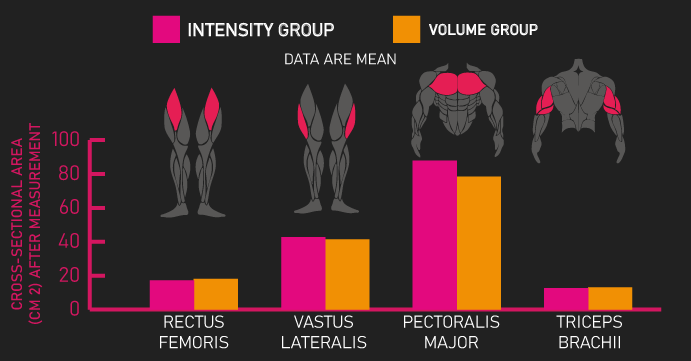
However, they also measured increases in lean leg and arm mass via DEXA scans. Increases in lean leg mass were similar between both groups, but increases in arm mass were significantly greater in the intensity group.
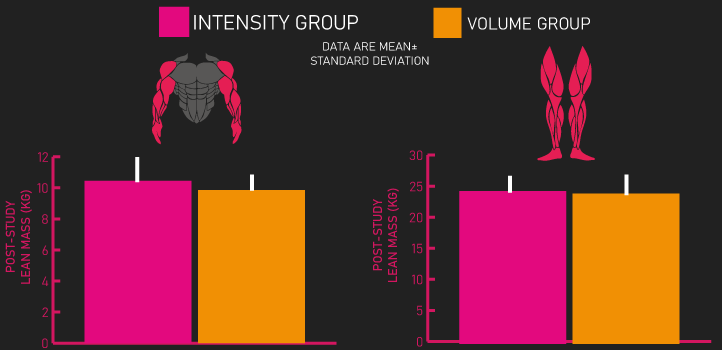
So overall, 3-5 reps were equally effective as 10-12 reps in most measures and actually superior in the lean arm mass measurement.
However, one limitation of this study was the intensity group used 3 minutes of rest between sets, while the volume group only used 1 minute.
In the complete guide to rest intervals article, we demonstrated the research suggests that with compound exercises, with all else equal, 2.5 or more minutes of rest between sets was superior to rest intervals of 1 minute or less.
With this in mind, the volume group would probably have been at a disadvantage. If they used a 3-minute rest interval, they could have experienced greater hypertrophy for all measures.
Let us put this limitation on the backburner for a little and continue evaluating the other research.
Schoenfeld et al. 2
Another study by Schoenfeld et al. split 17 men with at least 1 year of training experience into a strength group or hypertrophy group.
Both groups trained the same exercises 3 times per week for 8 weeks. The hypertrophy group used a bodybuilding split schedule, while the strength group used a full-body schedule.

The hypertrophy group trained each exercise with 3 sets of 10 reps to failure with 90 seconds of rest between sets.
The strength group trained each exercise with 7 sets of 3 reps to failure with 3 minutes of rest between sets.
Volume load (the product of sets x reps x load) was equated between the two groups, explaining why the strength group needed 7 sets per exercise and the hypertrophy group only 3 sets per exercise.
Increases in biceps thickness were similar between both groups, supporting the effectiveness of repetitions below 5 for building muscle.
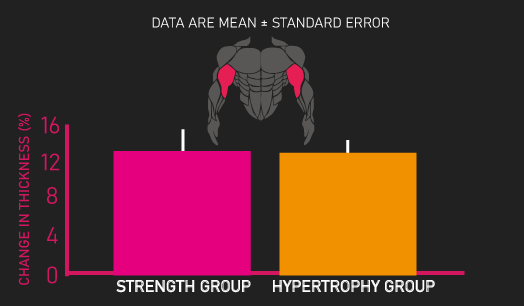
However, similar to the Mangine et al. study, the strength group used a 3-minute rest interval while the hypertrophy group used only a 90-second rest interval.
Additionally, I would argue equating volume load between groups is somewhat confounding.
The researchers justified this by stating volume load was strongly correlated to muscle growth, therefore equating it between groups would actually not be confounding.
But, strong evidence indicates that with all else equal, loads between 30% one-rep max and 85% one-rep max produce similar muscle growth.
For instance, Mitchell et al. found that when performing 3 sets to failure on the leg extension each session, using a 30% one-rep max load produced similar increases in quadriceps volume to using an 80% one-rep max load.
Volume load would have been significantly greater for the group using a 30% one-rep max load, yet growth was similar between groups.
Furthermore, we have research indicating more sets generally result in more hypertrophy (likely up to a certain point).
Considering all this, the strength group was probably put at an advantage with the more sets.
Nevertheless, let’s move on to the next study.
Before moving on, if you’re curious about creating an effective training program for muscle hypertrophy, our high quality partner Alpha Progression can help. It can generate a highly effective program for you, track your workouts live with in-built progression recommendations, provide graphs displaying your long term progress, and it has a massive exercise database with more than 550 exercises.
Click HERE (the link opens in a new tab) to get a free 2 week trial of the apps features. If you like it and go beyond, the link also gives you 20% off a subscription!
We never promote trash at the House of Hypertrophy, so rest assured the app is high quality. The reviews speak to this, 4.8 starts (based on more than 7,000 reviews) on Google play, and 4.9 stars in Apple’s store (based on nearly 400 ratings).
Campos et al.
Campos et al. split 27 untrained men into a low rep, intermediate rep, or high rep group.
All groups trained the leg press, squat, and leg extension for 8 weeks. 3 times per week for the first 4 weeks, and 4 times per week for the last 4 weeks.
The low rep group trained each exercise for 4 sets with a 3-5 rep-max load to failure and 3 minutes of rest between sets.
The intermediate group trained each exercise for 3 sets with a 9-11 rep-max load to failure and 2 minutes of rest between sets.
The high rep group trained each exercise for 2 sets with a 20-28 rep-max load and 1 minute of rest between sets.
Volume load was equated between groups, explaining why the groups used a different number of sets.
Increases in vastus lateralis type 1, type 2a, and type 2b fiber cross-sectional were similar between the low rep and intermediate group, and both greater than the high rep group.
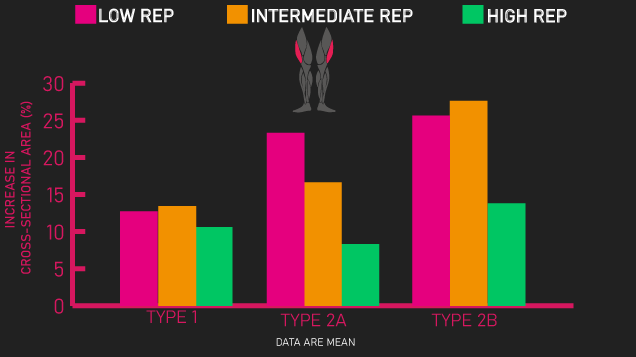
Therefore, this study supports the effectiveness of reps below 5 for muscle growth.
That said, equating volume load and the use of different rest intervals between groups are again confounding factors.
Chestnut and Docherty
Finally, Chestnut and Docherty split 19 untrained men into 4RM group or 10RM group.
Both groups trained the close grip bench press, triceps press down, biceps curls, dumbbell curls. These were the core exercises
They also trained the bench press, bench pulls, and shoulder press. These were the supplemental exercises.
These exercises were trained three times per week for 10 weeks.
The 4RM group performed 4 reps with an 85% one-rep max load to failure and 3 minutes of rest between sets. Each session, 6 sets were used for the core exercises and 2 sets for the supplemental exercises.
The 10RM group performed 10 reps with a 70% one-rep max load to failure and 2 minutes of rest between sets. Each session, 3 sets were used for the core exercises and 1 set for the supplemental exercises.
Increases in cross-sectional area for the middle and lower portion of the upper arm (which included the triceps, biceps, and brachialis muscles) were similar between both groups, supporting the effectiveness of reps below 5 for building muscle.
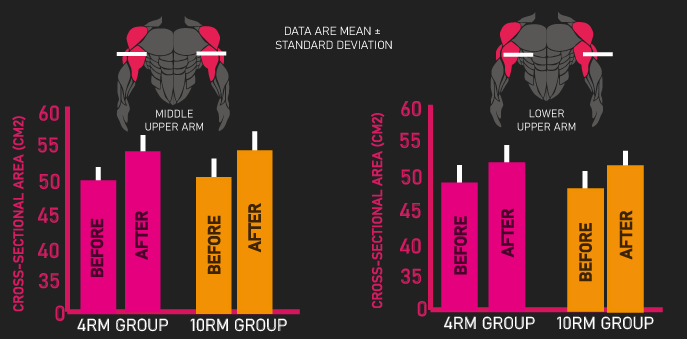
Again, equating volume load and the use of different rest intervals are potential confounding factors in this study.
Conclusion
To sum up, the vast majority of evidence supports the idea reps between 2 to 4 are effective for building muscle.
Having said this, of the 5 studies finding this, either they had the low rep groups perform more sets, in attempts to equate volume load, and/or the low rep groups used longer rest periods. Based on the reasons provided in the article, these are probably confounding factors.
Interestingly, the only two studies that did not have these confounding factors are in direct conflict with each other.
Weiss et al. suggests sets of 3-5 reps can maximize growth, whereas Schoenfeld et al. suggests sets of 2-4 are not as effective as sets of 8-12.
Slight differences, such as the use of 2 reps in the Schoenfeld et al. study and the use of 3 reps in the Weiss et al. study, could be a reason for these different results.
Nevertheless, more research that avoids those confounding factors is most definitely required.
What is clear though is that reps between 2-4 do have the capacity to build significant muscle. Perhaps, as most of the studies in this video did, you may have to perform more sets than usual and ensure longer rest intervals to achieve this.
Note, in most of the studies mentioned here, strength gains (one-rep max gains) were greater for low rep groups.
Therefore, if you are looking for some degree of hypertrophy, but your priority is strength gains, using reps between 2 to 4 is likely going to be effective.
Conversely, if your goal is hypertrophy, to err on the side of caution, it’s probably sensible to ensure most of your training is done in the 5 to 35 rep zone.
Interestingly, there does exist research exploring reps higher than 35 for muscle hypertrophy. We’ve evaluated this research in another article. We’ve also covered the research answering if alternating rep ranges in your training program could improve muscle growth.
Remember to feel free to check out the Alpha Progression App if you’re interested. Also feel free to check out our free bench press e-book below.

